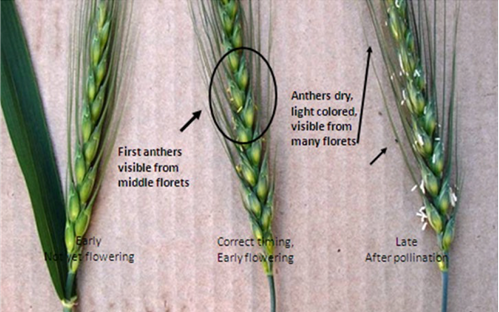Brought to you by: Jonah T. Johnson, MS, CPAg, CCA - Sales Agronomist, PCT | Sunrise
May 23, 2019: How does a soybean seedling emerge? What is the proper timing for “head scab” prevention in wheat?
Soybean Germination and Emergence
With many customers planting more soybeans earlier than we have seen in the past, it is also prime time to share information on how a soybean plant develops.
How a Soybean Plant Develops
VE
- 50% of seed weight absorbed as water
- Hypocotyl lengthens and pulls cotyledons with it
- Hypocotyl straightens as it reaches daylight
VC- Unifoliate leaves are expanded
- Cotyledons supply the nutrient needs, not roots
- Lose one cotyledon- typically no yield loss
- Lose both cotyledons- 2-7% loss (greater as you move north)
Nodulation
- Begins as soon as root hairs are present
- Root hairs are present within 5 day of planting
- Roots secrete tryptophan and other compounds which stimulate rapid growth of rhizobacteria
- Root hair bends and the bacteria enter the root hair.
- N fixation begins 2-3 weeks after initial rhizobial infestation.
What is the proper timing for “head scab” prevention?
Wheat “head scab” a.k.a. “Fusarium head blight” has potential to be a very destructive disease of wheat in Ohio, if proper environmental conditions are present. Head scab can reduce both yield and grain quality.
Quality losses can be due to lower test weights and production of a toxin (deoxynivelanol, or DON), by the head scab fungus. Both low test weight and contamination of the grain by DON can cause serious problems for producers and millers.
Environmental conditions are the “wildcard” to dictate the incidence and severity of a potential scab infection. Wheat is susceptible to the disease during flowering, weather conditions from flowering through kernel development play a key role in the incidence and severity of scab. Moderate temperatures (75 to 85°F), prolonged high humidity, and prolonged wet periods favor disease development.
The specific fungal pathogen that causes head scab in wheat (Fusarium graminearum) can also cause Gibberella stalk and ear rot in corn. That is why most agronomist do not recommend planting a corn-wheat rotation, or vice versa.
For successful head scab suppression, proper fungicide application timing is crucial for success. The ideal application timing to achieve around 50-60% control is exactly at GS stage 10.5.1. Growers should begin spraying when 75-100% of the wheat heads on the main stem are fully emerged (Feekes Growth Stages 10.3 to 10.51). See wheat head picture below.
In a normal year, that translates into about a 36-hour window for optimum timing; treating prior to or after that ideal window usually results in about a 10-20% loss in control for each day the window is missed. If a wheat variety planted has a strong varietal scab tolerance and a fungicide is used and applied at the proper timing, then we can typically achieve a 70% suppression of a head scab infection.
Regarding specific timing, our recommendation would be to apply these fungicides at or a few days after flowering in wheat for best results in terms of scab and vomitoxin control. OSU data suggests better control applying later than applying too early.
Fungicide application methods are also very critical. Use a minimum of 10 gallons of water per acre as a carrier, preferably 15 to 20 gal. Also, use a twin flat fan nozzle that sprays a fan forwards and backwards at about a 60-degree angle. This will give much better coverage of the wheat head, the goal in this type of application.

